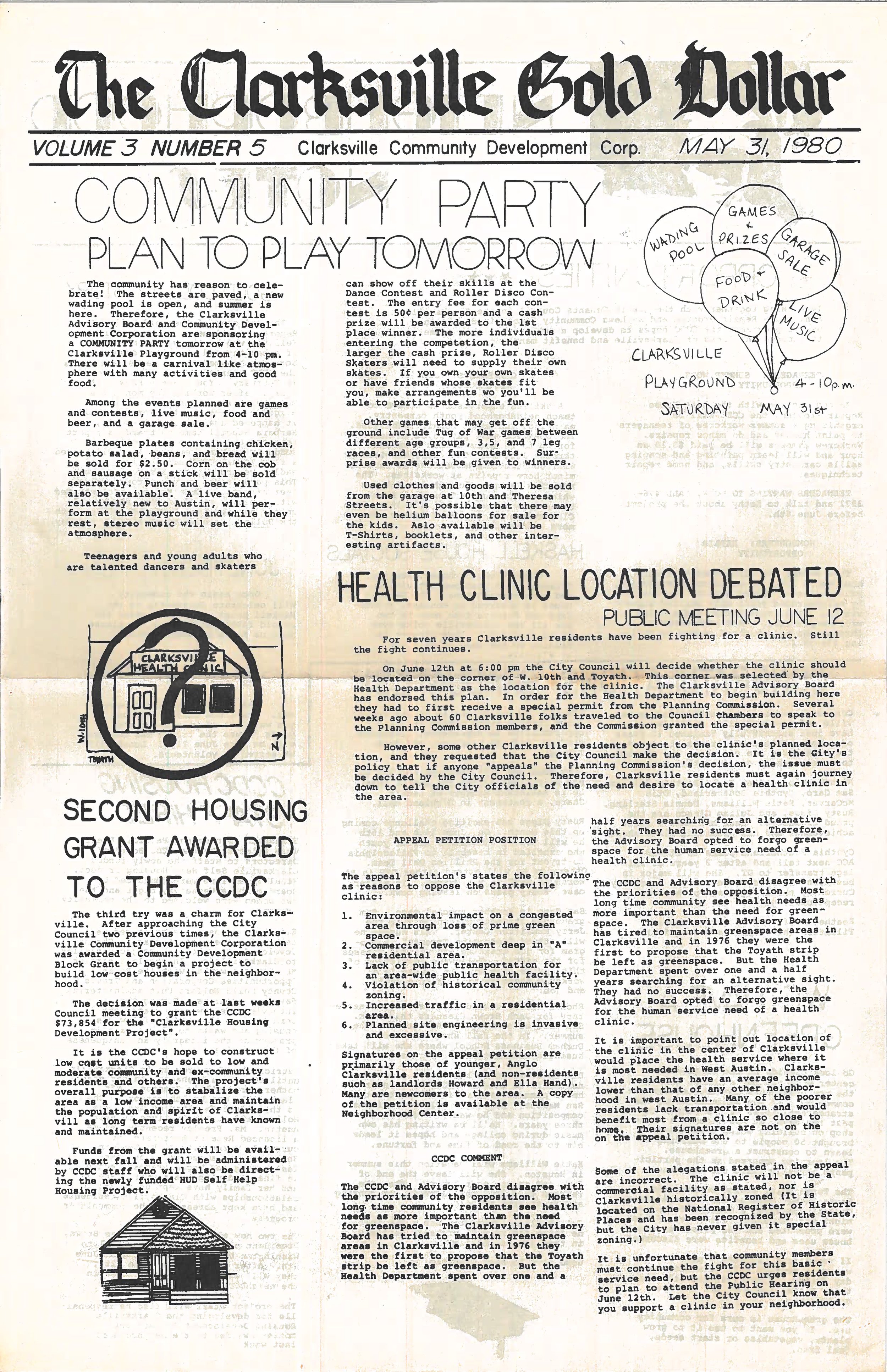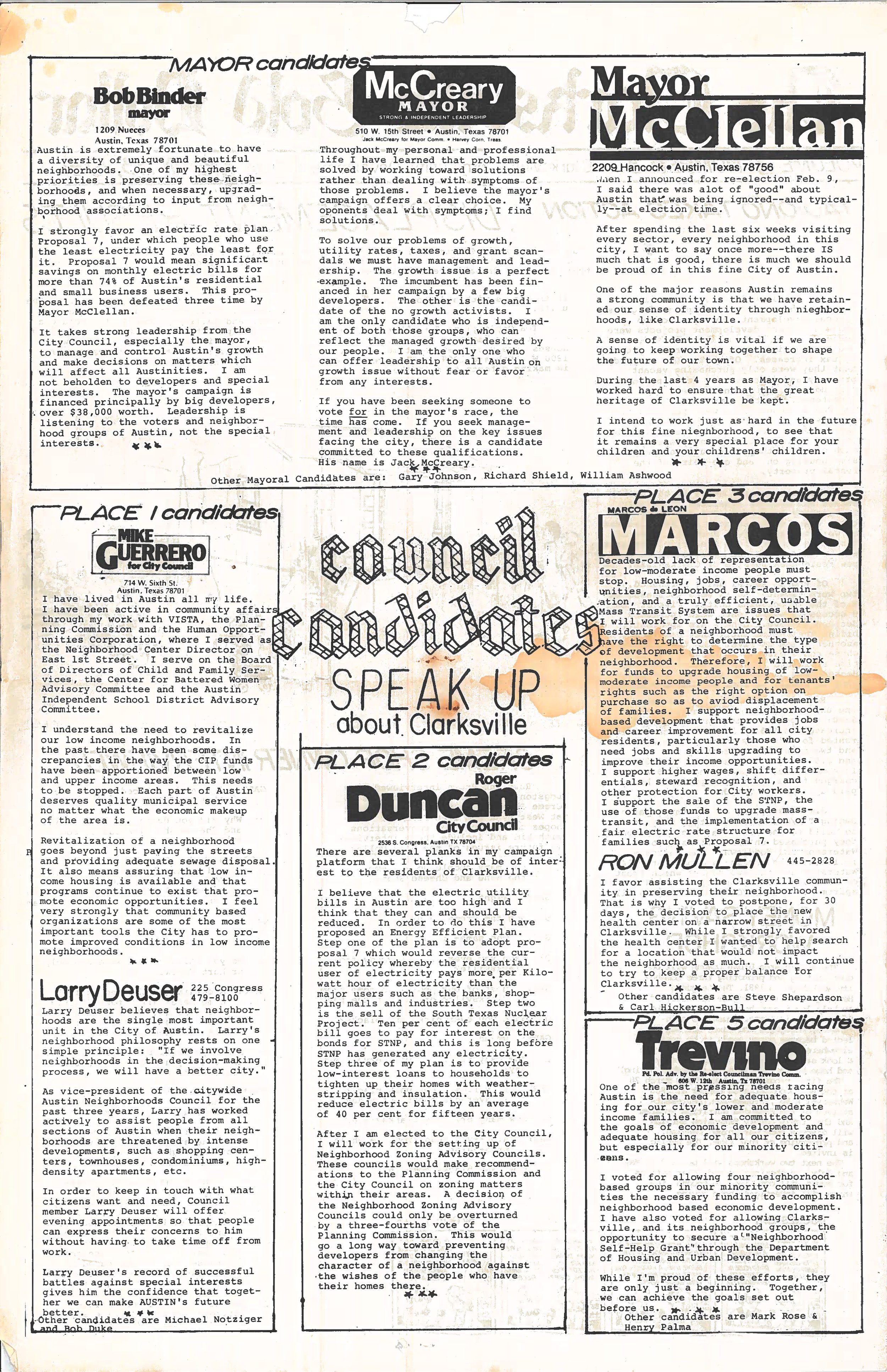History of the Clarksville Gold Dollar Newsletter
The 1970s and early 1980s in Clarksville were tumultuous. During these years, the still majority Black neighborhood was full of energy and hope, community involvement was high, and there were many important improvements in Clarksville. At the same time however, the neighborhood began confronting a powerful enemy – gentrification, which ultimately turned Clarksville into the affluent, mostly white neighborhood it is today.
A lot happened in the 1970s and early 1980s in Clarksville. The CCDC was established and began operating its affordable housing program; a community health center was built for residents; and Clarksville helped defeat construction of the Crosstown Expressway, which would have eliminated the neighborhood. Also, Clarksville’s advocacy resulted in the city finally paving neighborhood streets and installing an underground drainage system, ending decades of flooding. Also during this same time, high cost developments were sold to high income residents with no ties to Clarksville and Clarksville lost almost all its renters, mainly people of color. As properties changed ownership, rental properties were the first to change hands and tenants, often long-time Clarksville residents, had to leave the neighborhood.
During this time period, Mary Baylor, a City employee, ran the Clarksville Neighborhood Center, providing important services to Clarksville’s many low-income residents. The Center was also a neighborhood gathering spot and the place where the Clarksville’s neighborhood newsletter – The Clarksville Gold Dollar – was produced there between June 1975 and June 1981.
Kathy Tyler was a VISTA volunteer, neighborhood volunteer, and a city employee at the Neighborhood Center with Mary Baylor from 1973 until 1981. During her time there, she was involved with The Clarksville Gold Dollar. What follows are her memories of the newsletter.
The Clarksville Gold Dollar began in 1975 as the result of Mary Baylor, Pauline Brown, Lena Stewart, Reverend Southerland, John Henneberger, and I spending hours devising plans to help preserve and strengthen Clarksville and serve its residents. It was a way to distribute information to everyone in the neighborhood.
Writing the newsletter was a collective job, and neighborhood residents contributed some articles. For one or two years, the CCDC was able to employ a federal Comprehensive Employment and Training Act worker to write the newsletter. Her name was Melissa. She was a talented artist and you can tell the issues she produced because they include her illustrations. She would usually make a drawing from photos we'd take, or she'd freehand scenery.
Producing the newsletter was an arduous process. We'd type up articles in columns, cut them into strips and paste them down on a poster board with rubber cement. We used a lot of Liquid Paper because our typewriter did not have correcting tape. Once a newsletter was pasted on to the poster board, we would take it to Ginny's Printing where it would be copied onto a 11x17 sheet, copied front and back, and then folded in half. Most issues were one page, front and back. A few issues were multiple pages. We'd print maybe 200 copies.
I usually asked Skip Baylor and RuthAnn Brown to help me distribute the newsletters around the neighborhood. We would place them in the front doors of homes, covering W. 10th to Waterston from West Lynn to MoPac and including Patterson and Theresa to W. 6th. There were extra copies at the neighborhood center for folks who wanted more.
It was not unusual when I was delivering a newsletter on a particular block for the person at the end of that block to be able to recite all the stories in that issue of the Gold Dollar before I delivered it to them. This was because a neighbor at the beginning of the block would call that person to let them know about the newsletter’s contents. This happened all the time - a real life game of "telephone."
I'm not sure who named the newsletter, but I remember that all the folks in Clarksville were delighted to call the The Clarksville Gold Dollar as a way of honoring Reverend Jacob Fontaine. He was one of Sweet Home's founders and began a newspaper in 1876 called The Gold Dollar, which was one of the first Black newspapers in the South. Fontaine’s newspaper helped reunite family members who were separated and lost to one other because of the Civil War and slavery.
The Clarksville Gold Dollar helped keep the neighborhood informed. Its content initiated conversations, raised questions, and generated debates. People would often come to the Neighborhood Center to learn more about a particular topic and to voice their opinions. The newsletter was also an organizing tool because it encouraged residents to make a strong showing at city meetings that involved an issue affecting Clarksville and to present a unified message on behalf of the entire neighborhood.
The Gold Dollar newsletters that follow are from 1979 to 1981. They are a treasure trove of Clarksville history.
June 8, 1979
July 20, 1979
September 14, 1979
October 12, 1979
November 21, 1979
June 19, 1979
August 3, 1979
September 28, 1979
October 26, 1979
December 7, 1979
July 6, 1979
August 31, 1979
November 9, 1979
December 21, 1979
January 9, 1980
March 28, 1980
May 31, 1980
August 8, 1980
January 25, 1980
May 9, 1980
July 11, 1980
September 11, 1980
October 3, 1980
February 22, 1980
May 31, 1980
July 25, 1980
September 15, 1980
November 10, 1980
December 9, 1980
October 21, 1980
January 5, 1981
March 23, 1981
June 1, 1981
May 1, 1981
January 26, 1981










































































